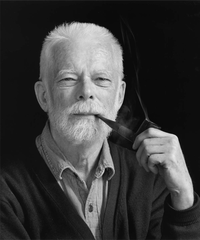Edward Nelson
| Edward Nelson | |
|---|---|
 Edward Nelson | |
| Born |
4th May 1932 Decatur, Georgia |
| Died |
10th September 2014 Princeton, New Jersey |
| Residence | United States |
| Citizenship | American |
| Alma mater |
|
| Known for | |
| Spouse(s) |
|
| Children | 2 |
| Awards | |
| Scientific career | |
| Fields | |
| Institutions | |
| Thesis | On the Operator Theory of Markoff Processes |
| Doctoral advisor | Irving Segal |
| Notable students | |
Edward Nelson (May 4, 1932 – September 10, 2014) was a professor in the Mathematics Department at Princeton University. He was known for his work on mathematical physics and mathematical logic. In mathematical logic, he was noted especially for his internal set theory, and views on ultrafinitism and the consistency of arithmetic. In philosophy of mathematics he advocated the view of formalism rather than platonism or intuitionism. He also wrote on the relationship between religion and mathematics.
Biography
Born in Decatur, Georgia, in 1932, Nelson lived in Italy as a child under the dictatorship of Mussolini. Nelson moved with his mother to New York City before World War II while his father, who spoke fluent Russian, stayed in St. Petersburg in connection with issues related to prisoners of war. After the war he returned to Italy for high school.
He received his Ph.D. in 1955 from the University of Chicago, where he worked with Irving Segal. He was a member of the Institute for Advanced Study from 1956 to 1959. He held a position at Princeton University starting in 1959, attaining the rank of professor there in 1964 and retiring in 2013.
In 2012 he became a fellow of the American Mathematical Society.[1] He died in Princeton, New Jersey on September 10, 2014.[2]
Academic work
Stochastic quantum mechanics
Nelson made contributions to the theory of infinite-dimensional group representations, the mathematical treatment of quantum field theory, the use of stochastic processes in quantum mechanics, and the reformulation of probability theory in terms of non-standard analysis.For many years he worked on mathematical physics and probability theory, and he retained a residual interest in these fields, particularly in connection with possible extensions of stochastic mechanics to field theory.
Four color problem
In 1950, Nelson formulated a popular variant of the four color problem: What is the chromatic number, denoted , of the plane? In more detail, what is the smallest number of colors sufficient for coloring the points of the Euclidean plane such that no two points of the same color are unit distance apart?[3] We know by simple arguments that 4 ≤ χ ≤ 7. The problem was introduced to a wide mathematical audience by Martin Gardner in his October 1960 Mathematical Games column. The chromatic number problem, also now known as the Hadwiger–Nelson problem, was a favorite of Paul Erdős, who mentioned it frequently in his problems lectures.
Foundations of mathematics
In the later part of his career, he worked on mathematical logic and the foundations of mathematics. One of his goals was to extend IST (Internal Set Theory—a version of a portion of Abraham Robinson's non-standard analysis) in a natural manner that includes external functions and sets, in a way that provides an external function with specified properties unless there is a finitary obstacle to its existence. Other work centered on fragments of arithmetic, studying the divide between those theories interpretable in Raphael Robinson's Arithmetic and those that are not; computational complexity, including the problem of whether P is equal to NP or not; and automated proof checking.
In September 2011, Nelson announced that he had proved that Peano arithmetic was logically inconsistent.[4] An error was found in the proof, and he retracted the claim.[5]
Publications
Selected papers
- Nelson, Edward (1966). "Derivation of the Schrödinger Equation from Newtonian Mechanics" (PDF). Physical Review. 150 (4): 1079–1085. Bibcode:1966PhRv..150.1079N. doi:10.1103/PhysRev.150.1079. ISSN 0031-899X.
- Nelson, E. (1986). "Field Theory and the Future of Stochastic Mechanics". In Albeverio, S.; Casati, G.; Merlini, D. Stochastic Processes in Classical and Quantum Systems. Berlin: Springer-Verlag. pp. 438–469. doi:10.1007/3-540-17166-5. ISBN 978-3-662-13589-1. OCLC 864657129.
Books
- Nelson, E. (1967). Dynamical theories of Brownian Motion. Princeton: Princeton University Press. ISBN 978-0-691-07950-9. OCLC 769464.
- Nelson, E. (1967). Tensor Analysis. Princeton: Princeton University Press. LCCN 67028943. OCLC 988417.
- Nelson, E. (1969). Topics in Dynamics: I: Flows. Princeton: Princeton University Pres. ISBN 0-691-08080-1. LCCN 79108265. OCLC 59197.
- Nelson, E. (1985). Quantum Fluctuations. Princeton: Princeton University Press. ISBN 0-691-08378-9. LCCN 84026449. OCLC 11549759.
- Nelson, E. (1986). Predicative Arithmetic. Princeton: Princeton University Press. ISBN 0-691-08455-6. LCCN 86018730. OCLC 14001745. [6]
- Nelson, E. (1987). Radically Elementary Probability Theory. Princeton: Princeton University Press. ISBN 0-691-08473-4. LCCN 87003160. OCLC 15591889.
See also
References
Notes
Bibliography
- American Mathematical Society (2012). "List of Fellows of the American Mathematical Society". ams.org. American Mathematical Society. Archived from the original on 2012-12-05.
- Baez, J. (2011). "The Inconsistency of Arithmetic". golem.ph.utexas.edu. The n-Category Café. Archived from the original on 2017-06-07.
- Katz, M. G.; Kutateladze, Semen S. (2015). "Edward Nelson (1932–2014)" (PDF). The Review of Symbolic Logic. 8 (03): 607–610. arXiv:1506.01570. doi:10.1017/S1755020315000015. ISSN 1755-0203.
- Kelly, M. (2014). "Edward Nelson, Nonconformist who Sparked a Quantum Field Theory Revolution, Dies at 82". princeton.edu. Princeton University. Archived from the original on 2017-06-07.
- Nelson, E. (2011). "Inconsistency of P". cs.nyu.edu. Foundations of Mathematics. Archived from the original on 13 May 2017.
- Princeton University (2014). "Professor Emeritus Edward Nelson Passed Away September 10th". math.princeton.edu. Archived from the original on 2014-09-11.
- Soifer, A. (2009). The Mathematical Coloring Book: Mathematics of Coloring and the Colorful Life of its Creators. New York: Springer. ISBN 978-0-387-74640-1. LCCN 2008936132. OCLC 233933503.
- Wilkie, A. J. (1990). "Book Review: Predicative Arithmetic" (PDF). Bulletin of the American Mathematical Society. 22 (2): 326–332. doi:10.1090/S0273-0979-1990-15900-2. ISSN 0273-0979.
External links
| Wikiquote has quotations related to: Edward Nelson |